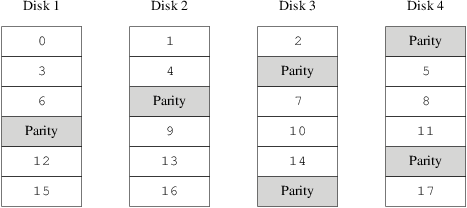The final problem with disks is that they are unreliable. Although reliability has increased tremendously over the last few years, disk drives are still the most likely core component of a server to fail. When they do, the results can be catastrophic and replacing a failed disk drive and restoring data can result in server downtime.
One approach to this problem is mirroring, or RAID-1, which keeps two copies of the data on different physical hardware. Any write to the volume writes to both disks; a read can be satisfied from either, so if one drive fails, the data is still available on the other drive.
Mirroring has two problems:
It requires twice as much disk storage as a non-redundant solution.
Writes must be performed to both drives, so they take up twice the bandwidth of a non-mirrored volume. Reads do not suffer from a performance penalty and can even be faster.
An alternative solution is parity,
implemented in RAID levels 2, 3, 4 and 5.
Of these, RAID-5 is the most interesting. As
implemented in vinum, it is a variant
on a striped organization which dedicates one block of each
stripe to parity one of the other blocks. As implemented by
vinum, a
RAID-5 plex is similar to a striped plex,
except that it implements RAID-5 by
including a parity block in each stripe. As required by
RAID-5, the location of this parity block
changes from one stripe to the next. The numbers in the data
blocks indicate the relative block numbers.
Compared to mirroring, RAID-5 has the advantage of requiring significantly less storage space. Read access is similar to that of striped organizations, but write access is significantly slower, approximately 25% of the read performance. If one drive fails, the array can continue to operate in degraded mode where a read from one of the remaining accessible drives continues normally, but a read from the failed drive is recalculated from the corresponding block from all the remaining drives.
